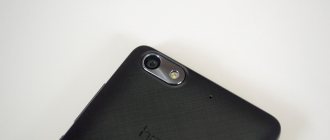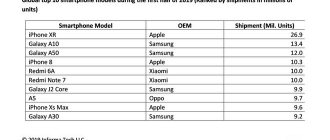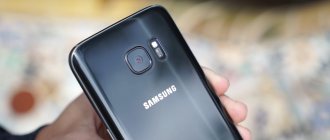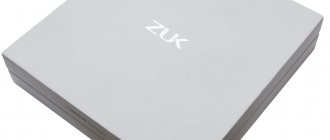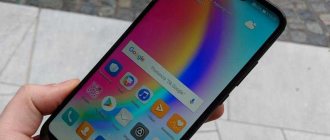While wandering the Internet, you have most likely already come across reports of friction between the Chinese corporation Huawei and the US authorities. Allegedly, Chinese technology threatens the American communications infrastructure. The consequence was the disconnection of all future devices of the company from Android. Google has pledged to support current devices until August 19, 2019. On which platform Huawei devices will be released starting in 2020 is a mystery.
But fortunately, such representatives of the Chinese technology giant as Honor 20 Pro or Huawei P30 managed to “be born” with the coveted Android 9.0. And if Honor is considered a democratic brand in the middle price segment, then P30 is the elite. Let's see how the favorites of the Celestial Corporation are better than the strong middle peasants. And is it better?
Comparison of characteristics
Both of our subjects belong to the major league in their niches, so there are certain similarities. This includes a set of rear cameras (3 sensors for Huawei P30, 4 for Honor), powerful processors (of the same model) and a solid supply of RAM. Bluetooth 5.0, 3.4G, navigation and other peripherals are at the same level.
Radical differences in the general characteristics are visible in two places:
- The fingerprint scanner on the Honor 20 Pro is located at the end, next to the volume rockers, while on the P30 it is located under the screen;
- Dust and moisture protection. Huawei P30 has IP53 protection. The opponent cannot boast of this.
| Honor 20 Pro | Huawei P30 | |
| Price | 599 euros | 699 euros |
| Available | May 2019 | March 2018 |
| operating system | Android Pie 9 + Magic UI 2.1 | Android Pie 9 + EMUI 9.1 |
| display | 6.26 inches 2340x1080, 19.5:9 OLED display, 412ppi | 6.1 inches 2340x1080, 19.5:9 OLED display, 422ppi |
| CPU | 2.4GHz Kirin 980 Octa-core processor | 2.4GHz Kirin 980 Octa-core processor |
| Graphic arts | Mali-G76 | Mali-G76 |
| Memory | 8GB | 6GB |
| Storage | 256GB | 128GB |
| MicroSD support | No | Up to 256 GB |
| connection | Dual-band 802.11ac Wi-Fi, GPS, Bluetooth 5.0 | Dual-band 802.11ac Wi-Fi, GPS, Bluetooth 5.0 |
| Fingerprint's scanner | Yes - side | Yes - on the display |
| NFC | Yes | Yes |
| Rear camera: | 48Mp with OIS telephoto lens + 8Mp (3x) + 16Mp ultra-wide angle + 2Mp macro | 40Mp with telephoto OIS + 8Mp (3x) + 20Mp |
| Rear camera: video | 48Mp with OIS telephoto lens + 8Mp (3x) + 16Mp ultra-wide angle + 2Mp macro | 40Mp with telephoto OIS + 8Mp (3x) + 20Mp |
| Front camera: stills | 32Mp, f/2.0 | 32Mp, f/2.0 |
| Front camera: video | 32Mp, f/2.0 | 32Mp, f/2.0 |
| audio | Mono speaker | Stereo speakers, 3.5 mm jack |
| waterproofing | No | IP53 rating |
| battery | 4000mAh | 3650mAh |
| Charging technology | USB-C SuperCharge 22.5W | USB-C SuperCharge 22.5W |
| Dimensions | 154.6 x 74 x 8.4 mm | 149.1 x 71.4 x 7.6 mm |
| Weight | 182g | 165g |
Revolution again?
Huawei presented three flagships with a different set of cameras: three in P40, four in P40 Pro and five in P40 Pro+. Of course, the most revolutionary is the latter, but he will not come to Russia. Therefore, we are content with what we are given.
They scored on the DxOMark rating - this is for the better. Someone needs to stop paying them.
The main sensor is 50 MP RYYB, f/1.9 aperture with optical stabilization and a huge sensor size of 1/1.28″. Thanks to its size, it receives 40% more light. Nearby there is a special temperature sensor to accurately determine the white balance.
The second sensor is a 40 MP wide-angle with an f/1.8 aperture. It’s great that the resolution is high, but the viewing angle is noticeably smaller than the iPhone 11 Pro. But you can take excellent night pictures with it.
The third sensor is a periscope, 12 megapixels with f/3.4 aperture and optical stabilization. It provides 5x optical zoom. There is also 10x hybrid and 50x digital.
Wide Angle
1x
5x
10x
Wide angle 1x
5x
10x 10x
5x 10x
5x
There are only four switches in the camera application: wide, 1x, 5x and 10x. The rest you have to figure out yourself. To be honest, the idea is not for me. 2x or 3x zoom is ideal, but 5x is somehow too much.
The preview of Huawei smartphones has always amazed me. You look - it’s somehow ugly, you take a photo - it’s beautiful. Sometimes it's worth saying thank you to AI.
The cameras can record 4K at 60 fps as much as possible, no 8K for you. But there is super slow motion 7680 fps - no one has surpassed this record yet. During normal shooting, despite optical stabilization, the image twitches noticeably at 4x.
I forgot to mention the fourth module - this is a ToF sensor for beautiful, clear portraits. We expect the same in the iPhone 12 Pro. Personally, I still don’t understand its purpose; I don’t photograph portraits at all.
The front camera is 32 megapixels, f/2.2 aperture, and can also record 4K video at 60 fps. At night, the screen turns on full to illuminate the face. But overall, I liked the quality, both during the day and at night.
I took the liberty of a quick comparison with the iPhone 11 Pro. I took both night and day photos. You can judge for yourself. To avoid any confusion, let’s start with daytime photos taken on the main sensor.
I was surprised that the viewing angle of the wide Huawei P40 Pro is smaller than that of the iPhone 11 Pro. I also attach examples.
Now in poor lighting conditions - both with and without night mode.
And here is a photo with an asterisk. At first glance, it seems that the P40 Pro is a beauty compared to the iPhone 11 Pro. But everything actually looked exactly as the iPhone showed. Apparently, the temperature sensor showed something different, and the AI modified it, resulting in a lot of green color coming from somewhere.
Design and ergonomics
Huawei P30 flaunts an aluminum-glass body with Aurora, Classic Black and Breathing Crystal color options. The neat, smooth lines of the phone just beg to be held in your hand. The volume buttons and the power key are located on the right side of the gadget. The connectors include Type-C for charging, and the familiar 3.5 mm for connecting a headset. The drop-shaped cutout for the front camera is located strictly in the top center and looks quite organic.
Honor 20 Pro, in turn, also boasts an aluminum-glass design. Regarding smoothness, the device is difficult to distinguish from its rival. Still no sharp corners. Smooth and beautiful. However, the place for the front camera was chosen here in a non-standard manner. Namely, at the top left of the display. A kind of “hole” in the screen. The left-sided placement of the selfie lens can be quite uncomfortable for left-handed people, so from this point of view, the latter will lose this round of the Huawei P30 vs Honor 20 Pro battle. Huawei, by the way, weighs 165 grams, which is quite good for a metal-glass 6-incher.
As for the connectors, Honor’s everything is a little poorer: only one Type-C, which is both charging and space for the headset (with an adapter). Either that or buy wireless accessories. The volume buttons and the power key (also known as the fingerprint sensor) are still there – on the right side. Weight is 182 grams, which is 17 grams heavier than the opponent. In terms of color palette, black and Phantom Blue are available.
Huawei P40 Pro review: sound
The “conversational” speaker cannot work in tandem with the “multimedia” speaker, so the desired stereo pair is missing in the P40 Pro.
As you know, Huawei Histen proprietary algorithms offer automatic adjustment of sound effects based on the content used. At the same time, along with simulating deep 3D surround sound (“close”, “front”, “surround”, “maximum”), natural and normal modes are also recommended. In the latter case, you not only have access to a 10-band equalizer with bass boost, five presets and individual settings, but also the ability to mark the type of audio accessory being connected.
A headset with a USB Type-C connector is included with the smartphone, since there is no 3.5 mm audio connector on the smartphone. To connect your own wired accessories you will need a regular mini-jack to USB Type-C adapter.
SBC, AAC, LDAC and HWA (LHDC) codecs are available for wireless Bluetooth headphones. Note that all aptX options are missing. With the Music app installed, you can play high-quality tracks, for example, from FLAC or WAV files. The Voice Recorder app saves your recordings, which you can tag along the way, in M4A (AAC LC) file format.
Display: LCD vs OLED
The twentieth Honor received an IPS LCD display with a diagonal of 6.26 inches with a resolution of 2340 by 1080. The protective glass seems to be as stated, but what exactly it is - history is silent. The pixel density is 412 pixels per inch. The screen-to-body ratio is 84.1%.
Huawei P30 has an OLED display with the same 2340 by 1080 resolution. But here the diagonal is 6.1 inches. Hardcore fans of “shovel-shaped” phones will consider this a minus. But there are not as many people with large palms or long fingers as it seems. And for the rest of the world’s population, holding smartphones much larger than 6 inches in their hands is, frankly speaking, inconvenient. The pixel density here is 398 ppi, and the usable screen area is 88.89%.
IP53 is a fairly high class of dust and moisture protection, but not absolute. If your phone will still be protected from raindrops and even in a downpour, then you still shouldn’t “bathe” it in a puddle or bathtub.
So, we draw an intermediate conclusion: in the next clash between Honor 20 Pro and Huawei P30, P30 will win again. Yes, even though IPS matrices are a little more affordable in price and a little brighter in light transmission, viewing angles, contrast and color saturation are all more about OLED screens.
Camera Huawei P30 Pro
At the moment, Huawei is the powerhouse of mobile photography, and therefore everyone's expectations for the P30 Pro camera were very high. With the new flagship, the manufacturer not only consolidated the success of previous models, but also broke away even further from competitors by implementing a number of unique technological solutions in the P30 Pro.
The main camera array consists of three modules, next to which there is an LED flash, laser autofocus and a ToF sensor. The latter is necessary to speed up focusing and create a scene depth map, due to which the algorithms are able to create a smoother blur that imitates the natural bokeh of high-aperture optics, rather than simply blurring the background behind the subject being photographed.
The main camera is based on a 40 MP sensor, which Sony developed exclusively for Huawei. The lens aperture is f/1.6, EGF is 27 mm, there is optical stabilization. The new sensor is notable for its non-standard subpixel structure - RYYB, which, according to the manufacturer, allows the matrix to collect 40% more light in difficult shooting conditions. This is also facilitated by faster optics (f1/.6 versus f/1.8 for its predecessor) and the appearance of optical stabilization, which together allows the P30 Pro to take incredible pictures in low light.
The 20 MP ultra-wide-angle camera is equipped with optics with an f/2.2 aperture and an EGF of 16 mm. The module is the same as in the Mate 20 Pro, it has autofocus and supports macro photography from a distance of 2.5 cm.
The periscope telephoto lens is a key feature of the P30 Pro. The resolution of the third sensor is the same as in the telephoto cameras on the P20 Pro and Mate 20 Pro - 8 MP, but its size has become larger, the pixels have increased from 1 to 1.22 microns. The matrix itself is located on the right, perpendicular to the camera array. In the square hole you can see the periscope lens, which refracts light onto the matrix at an angle of 90 degrees. The unusual layout allowed Huawei to implement optical stabilization and use optics with an EGF of 125 mm, which provides 5x (in fact 125/27 = 4.63x) optical zoom, which today is a record among smartphones. The P30 Pro can also take photographs with 10x hybrid zoom and 50x digital zoom.
The camera app itself remains largely unchanged from the Mate 20 Pro. There are many functions, but everything is intuitive and learning the settings takes a lot of time. Photos on the main 40 MP module are taken at 10 MP resolution by default; there is RAW shooting for all cameras. Overall, in good lighting, the photos on the P30 Pro are some of the best photos a smartphone camera can take today. The level of detail and dynamic range are close to reference standards, and colors are accurate without undue embellishment, even when using HDR, which sharpens images slightly.
Although, when using the AI mode, the algorithms still suffer from overly saturated coloring of the sky and plants.
In low light, the automatic mode shows good results, but is inferior to what you can get from the camera using manual settings or night mode. It makes sense to keep HDR turned on even at night, it improves detail and reduces noise.
All 3 cameras can shoot in night/pro mode. Overall, the P30 Pro performs amazingly well in low light, significantly outperforming flagships from other manufacturers.
As for the wide-angle camera, the quality of images during the day does not differ much from the main module. Color rendition and detail are good, distortion at the edges of the frame is minimal. At night, due to the lack of optical stabilization, the gap increases, but when using the night mode, the increase in quality compared to the Mate 20 Pro is noticeable.
The P30 Pro is ideal for macro photography; in terms of its minimum focusing distance, it is one of the most advanced cameras on the market. The smartphone is excellent at shooting all kinds of petals, bugs and other small objects.
The camera, despite its modest 8 MP resolution, takes impressive photos with a five-fold zoom. The 10x zoom is a hybrid, that is, the original 5x image is cropped 2 times, and this is noticeable, since the picture loses detail and becomes more watercolor. But no other smartphone is capable of providing comparable quality of 10x zoom. The 50x zoom is more technical than creative; now you have portable binoculars in your pocket that allow you to view distant inscriptions and objects.
The quality at 50x zoom is obviously poor, but the very possibility of such pictures is amazing. Among the nuances, it is worth noting that the 2x-4x zoom is a hybrid, and in terms of detail it is slightly inferior to pictures with a 5x optical zoom.
Portrait mode is intended solely for photographing people. In it you can choose the nature of the bokeh (hearts, swirls, circles, etc.), use lighting effects and various color filters. Background blur is implemented well, it accurately trims the contours of the object and looks natural, you can even photograph moving objects.
In the aperture blur mode, the focus point and blur intensity in the range f/0.95 – f/16 can be set on finished photos in the gallery. The mode is aimed at photographing various objects, but if you don’t need effects and embellishments in portrait photography, it can also be used for portraits, since the blur settings are more flexible here.
The selfie camera has an impressive 32 MP resolution and f/2.0 aperture, but the focus is fixed. This means that your face will be sharp at arm’s length, and you won’t be able to photograph a group of people, for example, by attaching your smartphone to a selfie stick. The front camera supports portrait photography and lighting effects; at night, detail remains at a decent level.
The P30 Pro records 4K video at 30fps – there's still no 4K/60fps mode. 4K video bitrate is 26 Mbit/s, h.264 and h.265 codecs are available to choose from. When recording videos, the device is very versatile due to lenses with different focal lengths, switching between them is carried out almost instantly. In good lighting, you get effectively stabilized video with a wide dynamic range and correct color rendition; detail is good, but not the best among flagships.
Night videos moderately lose clarity, but due to the strange stabilization work on the main camera, noticeable jitter of the matrix appears when moving.
Hardware and performance
Here, we can say, at the same time, about both Honor and Huawei P30. Inside, both have Huawei's own brainchild - HiSilicon Kirin 980. 8 cores under one harness provide simply amazing power for a mobile device (2 at 2.6 GHz, 2 at 1.92 GHz and 2 at 1.8 GHz). We add here the ARM Mali-G76 MP10 graphics chip - and the result is a unit that can easily cope with gaming hits like Fortnite, Mortal Kombat X, Injustice 2 and, of course, PUBG.
RAM, 6 GB Huawei P30 and 8 GB Honor 20 Pro, only adds fuel to the fire, making your smartphone a real god of the mobile arena. But, as we see, specifically between the two phones being compared, in this diocese the “people’s” flagship from Honor took the lead.
You can store your multimedia data on the Huawei P30 on 128 GB of internal memory, while Honor provides 256 GB for this purpose. In total, this is the second plus for the budget employee. Although, of course, it is worth recognizing that you can insert a memory card into the P30, but not into the Honor. But the nano-memory form factor speaks of very expensive flash drives. Yes, and let's be honest. In the age of cloud storage and the ability to throw excess onto a computer or portable hard drive, the built-in 256 GB should be enough for another couple of years. But 128 GB, taking into account the increasingly “heavier” operating systems, games and films, is not a fact...
Camera
The main thing about this smartphone is its five-camera system. The standard module is built on a Sony IMX700 sensor measuring 1/1.2 inches. The resolution is 50 megapixels; by default, the camera shoots at 12.5 megapixels, combining four adjacent pixels into one. It also received optical stabilization and an f/1.9 aperture lens developed jointly with Leica.
Photo: Artyom Bagdasarov / Lifehacker
In addition to the standard module, there is a 40-megapixel “wide” camera with an f/1.8 aperture, a Time-of-Flight depth sensor and two 8-megapixel cameras for zoom: with 3x and 10x zoom. It is the latter that makes the smartphone stand out from all the others: it contains three mirrors and a prism that refract the light flux five times.
Zoom camera device. Huawei promotional materials
The daytime shots are simply stunning. There is no hint of aggressive compression or excessive sharpening; the camera preserves maximum details and halftones. I'm glad that there is an intermediate zoom: 10x magnification is excessive in many situations. By the way, due to the f/4.4 aperture, the periscope does not shoot well in the dark.
The smartphone records video in 4K resolution with a frame rate of 60 FPS and stereo sound. By default, shooting is done with a wide-angle lens, which gives the maximum viewing angle and slight shaking. The quality is also decent.
Camera comparison
There are no bad cameras on flagships. Regardless of whether it is a budget smartphone or not. The ultra-wide-angle camera and telephoto sensor are the same on the Honor 20 Pro and P30 (16 and 8 megapixels, respectively). “Ultrawide” in both cases has an aperture of 2.2 and digital image stabilization. The telephoto lens boasts more powerful optical stabilization and an f/2.4 aperture. The photos turn out quite vibrant, but in both cases, as is the case with Huawei products, in low light the colors turn out to be slightly “poisonous” (oversaturated).
Honor's main lens is 8 megapixels larger (48 MP versus 40). Plus, the fourth sensor of the 20 Pro is a 2MP macro lens, which allows you to take pictures of small objects from a distance of 4 centimeters. The P30 has no analogue to this sensor.
The Huawei P30 records video in 2160 x 30fps, while its opponent does it twice as good: 2160 x 60fps.
Selfie sensors are the same here and have a resolution of 32 MP for each gadget. No stabilization, but stable Full HD with a resolution of 1920x1080, as well as portrait modes, a 3D function and all sorts of augmented reality features.
In both cases, the optics for smartphone production are provided by the Japanese company Sony.
⇡#Camera
Probably, the world will turn upside down when Huawei stops somehow shifting our ideas about what mobile phone cameras can do on P-series smartphones. However, the company started doing this not so long ago - and in this world everything is changing. But these mini-revolutions are happening too steadily. This time, a double thing happened: along with an unprecedented zoom (optical five-fold), a new type of sensor debuted in the smartphone - with a fresh color filter. First things first.
Huawei P30 Pro received four rear cameras at once. The quantity in this case is just the least interesting - the fourth was a miniature (hidden under the flash) TOF camera. Such solutions are becoming more common - thanks to these depth sensors, smartphones learn to better separate the object and the background, as well as measure objects and apply various virtual reality masks. But much more interesting here, of course, is the main module, which consists of three cameras.
Photo – GSM Arena
The main camera is based on a fresh 40-megapixel Sony sensor of physical size 1/1.7'', made using the Quad Bayer system. This means that by default it shoots at 10 megapixels, and the light hitting the clusters of four photodiodes is similar to the pixels in a 10-megapixel large sensor. Added to this is the completely new SuperSensing technology. Its essence is extremely simple - instead of the usual RGGB color filters, RYYB filters are used here, green subpixels are replaced with yellow ones, which allow you to receive 40% more light than green ones. In theory, this improves the sensor's low-light capabilities, but in practice careful software processing is required to avoid color distortion. And Huawei coped with this task.
| On the left is an example of night shooting by default, on the right is in night mode | ||
The smartphone can shoot in the dark at least at the level of the Huawei P20 Pro – and is noticeably ahead of the Mate 20 Pro in this regard. Even without activating the multi-exposure mode, getting a sharp and clear photo at night is not at all difficult. Adding to the effect, of course, is a lens with an aperture of ƒ/1.6 (focal length – 27 mm), and an optical stabilizer that works with both the main and telephoto cameras. The P30 Pro confidently takes the crown of the best smartphone for shooting in the dark, and I did not notice any damage to color reproduction. There are also no problems with dynamic range - forcing HDR is simply not necessary in most situations.
| On the left is a screenshot showing the actual lighting level, on the right is an example of a picture taken under these conditions | ||
The maximum light sensitivity with which a smartphone can shoot is ISO 409,600. It can, of course, be called “show sensitivity”, which is needed here for good measure, but even here everything is not so simple, the Huawei P30 Pro can actually work as a kind of analogue of the device night vision - a smartphone is able to “see” a picture even where you cannot see it with your own eyes. The shooting quality is not outrageous, but the “brains” of the device can bring the image to a more or less acceptable level. This is really very impressive.
| From left to right: ultra-wide field of view, normal field of view, 5x optical zoom, 10x hybrid zoom | ||||||
No less impressive is the telephoto module, which provides 5x optical zoom or 10x hybrid zoom (quality loss is minimal). This module uses an 8-megapixel sensor measuring 1/4'' (the pixel size is kept acceptable - 1.22 microns) with a periscope lens, which is located across the body. Light enters the sensor through a prism and five optical elements; a mirror is not used in this lens. The aperture is not at all impressive, ƒ/3.4, but we are talking about a 125mm lens without extendable parts in a smartphone. And it produces a pretty decent picture. During the day it’s generally good. At night, miracles, of course, do not happen: the combination of a low aperture ratio and a small matrix cannot but make itself felt, but the stabilizer is really effective, at least it is quite possible to take an unblurred picture. Moreover, with both fivefold and tenfold (250 mm!) zoom.
| Left: approximately 25x digital zoom, right: 50x | ||
I will add that digital zoom is ultimately available up to 50x! Yes, the image is frankly suffering, but you can see something - the wow effect is achieved.
| Top – picture without zoom, bottom from left to right: 2x, 3x, 4x and 5x zoom | ||||||
At this point, however, I had a complaint against Huawei. In pursuit of maddening numbers, the company seems to have forgotten a little about the user, who in most cases does not need such a zoom, but 2-3 times smaller - for shooting portraits and street scenes. At the same time, the entire range between 27 mm and 125 mm remains at the mercy of digital zoom. This is really a minus. The plus is that this digital (although again, as in the case of 10x zoom, hybrid) zoom works very well, at the level of Google Pixel 3. Moreover, up to 3x zoom, the telephoto module is not used at all, but for 3x -5x magnification, images from the telephoto and wide-angle modules are combined. In principle, the complaint is removed, but I would like the 2-3x zoom to be available in the on-screen menu, at least like the same “pixel” - it’s not very convenient to pinch your fingers together every time.
The ultra-wide-angle camera remains the same as in the Mate 20 Pro: 20 megapixels, 1/2.7'', ƒ/2.2 aperture optics and an equivalent focal length of 16 mm. It works with autofocus (unlike most competitors), and the minimum focusing distance is 2.5 cm from the subject. So far, Huawei smartphones are outperforming everyone in terms of macro photography quality too.
Of course, the camera is branded Leica, but no one has been focusing on this for a long time - it is obvious that the influence of the great German company on the smartphone camera is limited to proprietary fonts and three unchanged “film” filters. We must admit that Huawei does an excellent job on its own. I note that, despite the absence of a black-and-white sensor, the P30 Pro retains the monochrome shooting mode - and the frames in it look very thoroughbred.
Autofocus in the P30 Pro is not hybrid, but exclusively phase detection, but this did not affect its effectiveness in any way - except in a positive way. Focusing is tenacious, fast and stable in all lighting conditions. Artificial intelligence has not disappeared from the Huawei P30 Pro camera - you can turn it off at any time by touching the icon in the top row, and sometimes you want to do this - after all, the “brains” of the smartphone sometimes go overboard with image improvement.
The interface of the camera application has not changed - different modes are called up by horizontally swiping the screen, there is a professional mode with the ability to enter settings yourself. If desired, you can shoot in RAW format. HDR mode is not activated by default; it must be enabled separately. Of the new modes, I’d like to note a special one for underwater shooting - there is a special case for the P30 Pro that allows you to do this at a good level.
| Three focal length options are available for portraits | ||||
Portrait mode works very well. The smartphone is great at separating plans, both when shooting in large format and in full-length portraits, and can “draw” a variety of bokeh: in the form of circles, hearts, and so on. There are also sophisticated lighting effects like simulating Roman blinds or stained glass in the background (with corresponding reflections on the face). The same effects can be applied when shooting with a selfie camera. There is also a customizable beautifier, but it does not apply to the entire figure, as in Honor View 20. Who knows, maybe the option will be added in future firmware.
Overall, in terms of shooting quality, the Huawei P30 Pro sets a new bar for the entire mobile photography industry. And since even the Huawei P20 Pro/Mate 20 Pro has not yet been surpassed by its competitors, the new milestone is even more impressive. The only complaints we can make are that the toning is not always natural, both in general plans and in portraits (skin tone must be adjusted during processing), and the occasional errors in achieving contour sharpness. In terms of capabilities, the quality of shooting in the dark and the freedom provided to the photographer, the Huawei P30 Pro has no equal today.
Huawei P30 Pro
View all images (37)
Example of video shooting in 4K resolution
In video shooting, the P30 Pro is more modest. It can shoot video with a resolution of up to 3840 × 2160 and a frame rate of only up to 30 frames per second. They say that 4K/60p mode will be added in future firmware, but it is not there yet. Stabilization is available when shooting with a resolution of up to 1920 × 1080 s and a frequency of 60 frames per second, there is slow-motion video (frequency - 960 frames per second) with a resolution of 1280 × 720. “Rolling shutter” when shooting in 4K and image twitching have not disappeared anywhere - in video shooting, Huawei devices are still inferior to the iPhone, Samsung, and Sony. The filters tested in the Mate 20 Pro, which make the picture more “cinematic,” software background blur and color highlighting in an overall monochrome scene, are in place. What’s new is the ability to shoot simultaneously at a wide angle and using zoom; two images are displayed on the screen simultaneously, side-by-side. It is also worth mentioning that the zoom is available directly during shooting - you can switch between focal lengths on the fly.
The front camera has also been updated - the P30 Pro uses a 32-megapixel sensor with an ƒ/2.0 aperture lens, without autofocus and flash. The picture turns out to be of high quality in different lighting conditions, but the problem with this camera is an imperfectly chosen focus point (sometimes it takes too long to find the right distance) and too wide a viewing angle - the distortion of facial features, in my opinion, turns out to be too serious. I have already mentioned the possibility of blurring the background, beautifier and various filters above.
Colors
It's difficult to make a comparison here. Everything will simply depend on taste. One thing in common is that both models have a black color. And all the rest are variations of purple, green and blue. In a gradient design, of course. Specifically, Honor has Phantom Blue, and Huawei has Aurora and Breathing Crystal.
Gradient glass surfaces collect fingerprints quite quickly, keep in mind. But this can also be easily fixed by simply wiping the surface of your device.
What is better to choose
This is the finale. Let's compare the results. We take the more expensive Huawei P30 and dance from it. How it is stronger and in what ways it is inferior to its mid-budget counterpart.
Pros:
- OLED screen is better than IPS;
- an under-screen fingerprint scanner is a more modern solution than a body sensor;
- front camera – clearly in the center, in a drop-shaped cutout;
- you can insert a memory card (but expensive);
- there is a 3.5 connector, which means that most modern wired headphones will fit without an adapter;
- 17 grams lighter (165 versus 182 grams);
- dust and moisture protection IP53.
Minuses:
- 128 GB of memory instead of 256 GB of the opponent;
- 2 GB less RAM (6 versus 8 GB);
- there is no lens for macro photography;
- approximately 10% less battery charge;
- the main photo lens is 8 MP smaller (40 vs. 48 MP);
- about $240 more expensive (price varies depending on where you buy it).
Conclusion
The results of the battle between Honor 20 Pro and Huawei P30 are not as obvious as it might seem at the beginning of this article. So, if you are an avid gamer and sometimes like to photograph, say, flowers or insects, then the Honor 20 Pro with more RAM and permanent memory, and a macro lens is for you.
Or, if you often spend time outside, regardless of the weather, are often in places with high humidity, and also value good color rendition when watching movies, pictures, etc. – you’d better opt for the Huawei P30.


